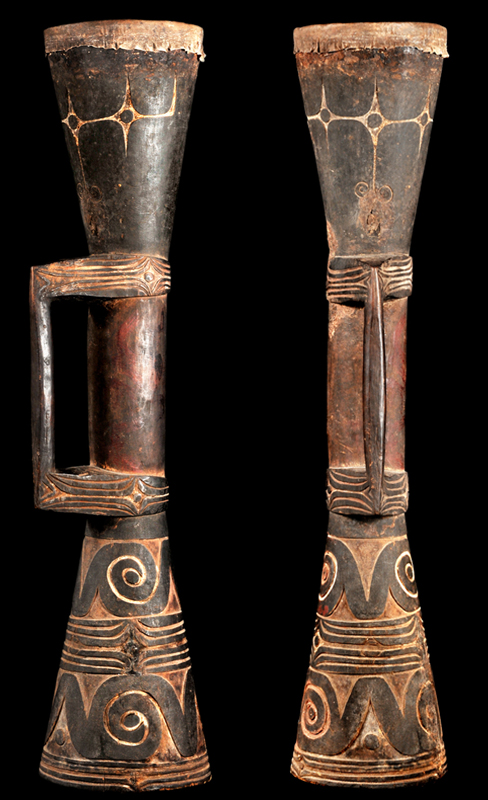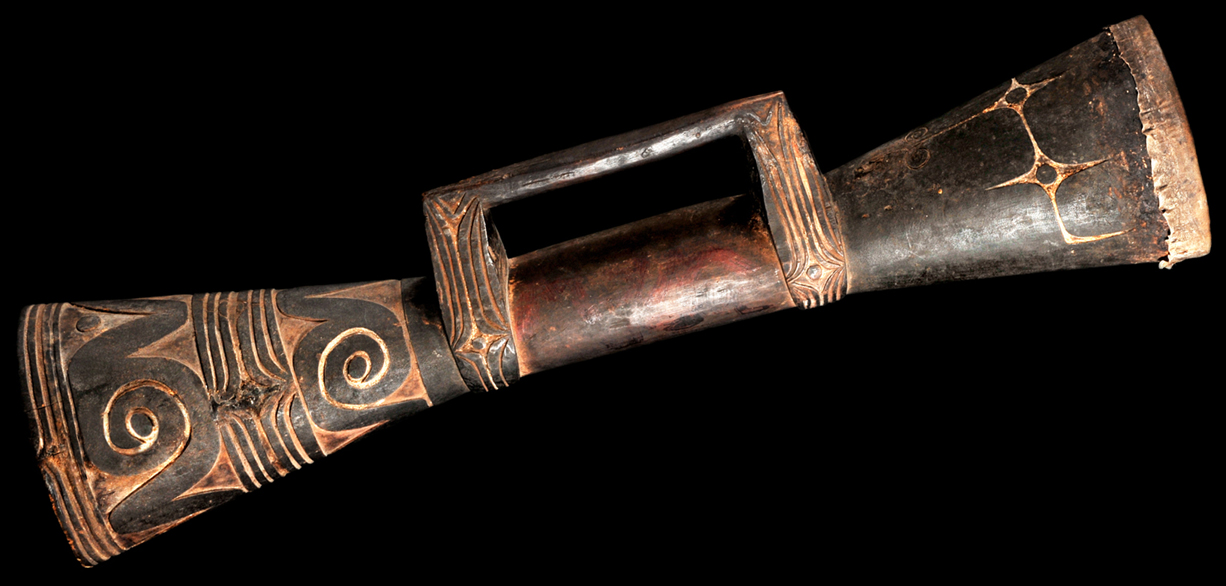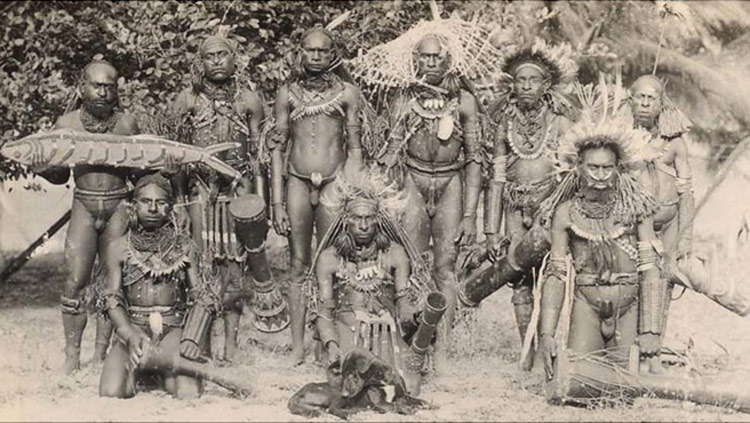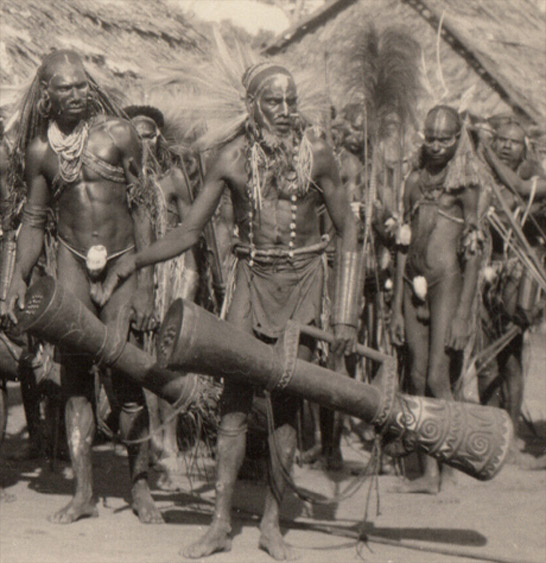DRUMS OF THE WORLD
New Guinea
Marind Anim drum New Guinea
Marind Anim drum New Guinea / Trommel Neuguinea / tambour Nouvelle Guinée
The Marind-anim drum has a narrow and cylindrical waist from which it widens towards the two ends.
A handle, forming a rectangle is set in the middle part. The size of these drums varies from some decimeters to more than one and a half metres. The skin used is that of the iguana, minyawak, or the kangaroo. The Marind-anim use a mixture of lime, blood and urine to make the glue to fix the skin to the drumhead. The blood is sometimes that of an animal, but in most cases it is obtained by making an incision, with a sharp piece of bamboo, in the glans of the drum's owner. The Marind-anim believe that a drum of which the skin is glued with such a glue will make a particularly cIear sound and will create a strong reaction in the women.
A number of tiny balls are usually to be found on the drumhead - or traces of them are - placed evenly in a square. These balls are made of the viscous substance which a particular kind of spider secretes in its abdomen for making its web. Skins are frequently seen with a square consisting of three rows of three of these tiny blobs or four rows of four. Their function is to improve the sound. In the event of the skin becoming slack during the playing of the drum, the right tension is again obtained by warming it over a fire.
Father Geurtjens gives a detailed description of the way in which the Marind-anim make their drums.
"The drums are made from the wood of a tree with a soft heartwood. A piece of the trunk is trimmed into the rough shape of a drum. One end is hollowed out a little and the piece of wood is then stood upright, the hollowed-out end uppermost. The lower end is stuck in the ground sufficiently to prevent its falling over. The hollowed-out end is then filled with water which is constantly and carefully replenished. Under the action of the water, the soft heartwood quickly begins to rot. The softened parts are then removed. When half of the cavity has been rotted away in this manner, the piece of wood is then reversed and the same thing is repeated at the other end. This process enables the innermost part to be pushed through with a piece of hard wood or a piece of bamboo. The result is a channel running through the length of the piece of wood. This channel is then widened by firing, the heat being regulated by bellows and the inside is scraped with shells and pigs' tusks. Internodes of bamboo are also made to explode in the cavity - if sound internodes of bamboo are held in a fire they burst open with a mighty bang. This is intended as sympathetic magie, the object being that the drum will produce a loud sound. When the required internal cavity has been obtained, the outside of the drum is then worked with an adze and finished off: carving is then done with pigs' tusks."
(excerpt from the book: Music in New Guinea – Three studies by Jaap Kunst - `S.Gravenhage-Martinus Nijhoff-1967)
Das Fell der kandara drum wurde mit einer Mischung aus Kalk, Blut und Urin aufgeklebt.
Das verwendete Blut stammte in der Regel vom Besitzer der Trommel.
Die Marind Anim glaubten, dass eine Trommel, deren Fell auf diese Weise aufgeklebt wurde, einen besonders klaren Klang hätte und eine starke Bewunderung bei Frauen hervorrufen würde.
Bibliography:
Baal, J. van 1966, Dema. Description and Analysis of Marind-Anim Culture South New Guinea). Translation series No. 9. The Hague: Koninklijk Instituut voor Taal-, Land- en Volkenkunde.
Wirz, Paul, Die Marind-anim von Hollaendisch Sued-Neu-Guinea. Friederichsen & Co., Hamburg, 1922 - 1925. 2 Vols.
Music in New Guinea – Three studies by Jaap Kunst - `S.Gravenhage-Martinus Nijhoff-1967
Collaer, Paul (1965) : Musikgeschichte in Bildern – Ozeanien. Musikethnologie1. Leipzig.
Fischer, Hans (1958) : Schallgeräte in Ozeanien. Sound-producing instruments in Oceania.
Graf, Walter (1950) : Die musikwissenschaftlichen Phonogramme Rudolf Pöchs von der Nordküste Neuguineas.
The Marind-anim drum has a narrow and cylindrical waist from which it widens towards the two ends.
A handle, forming a rectangle is set in the middle part. The size of these drums varies from some decimeters to more than one and a half metres. The skin used is that of the iguana, minyawak, or the kangaroo. The Marind-anim use a mixture of lime, blood and urine to make the glue to fix the skin to the drumhead. The blood is sometimes that of an animal, but in most cases it is obtained by making an incision, with a sharp piece of bamboo, in the glans of the drum's owner. The Marind-anim believe that a drum of which the skin is glued with such a glue will make a particularly cIear sound and will create a strong reaction in the women.
A number of tiny balls are usually to be found on the drumhead - or traces of them are - placed evenly in a square. These balls are made of the viscous substance which a particular kind of spider secretes in its abdomen for making its web. Skins are frequently seen with a square consisting of three rows of three of these tiny blobs or four rows of four. Their function is to improve the sound. In the event of the skin becoming slack during the playing of the drum, the right tension is again obtained by warming it over a fire.
Father Geurtjens gives a detailed description of the way in which the Marind-anim make their drums.
"The drums are made from the wood of a tree with a soft heartwood. A piece of the trunk is trimmed into the rough shape of a drum. One end is hollowed out a little and the piece of wood is then stood upright, the hollowed-out end uppermost. The lower end is stuck in the ground sufficiently to prevent its falling over. The hollowed-out end is then filled with water which is constantly and carefully replenished. Under the action of the water, the soft heartwood quickly begins to rot. The softened parts are then removed. When half of the cavity has been rotted away in this manner, the piece of wood is then reversed and the same thing is repeated at the other end. This process enables the innermost part to be pushed through with a piece of hard wood or a piece of bamboo. The result is a channel running through the length of the piece of wood. This channel is then widened by firing, the heat being regulated by bellows and the inside is scraped with shells and pigs' tusks. Internodes of bamboo are also made to explode in the cavity - if sound internodes of bamboo are held in a fire they burst open with a mighty bang. This is intended as sympathetic magie, the object being that the drum will produce a loud sound. When the required internal cavity has been obtained, the outside of the drum is then worked with an adze and finished off: carving is then done with pigs' tusks."
(excerpt from the book: Music in New Guinea – Three studies by Jaap Kunst - `S.Gravenhage-Martinus Nijhoff-1967)
Das Fell der kandara drum wurde mit einer Mischung aus Kalk, Blut und Urin aufgeklebt.
Das verwendete Blut stammte in der Regel vom Besitzer der Trommel.
Die Marind Anim glaubten, dass eine Trommel, deren Fell auf diese Weise aufgeklebt wurde, einen besonders klaren Klang hätte und eine starke Bewunderung bei Frauen hervorrufen würde.
Bibliography:
Baal, J. van 1966, Dema. Description and Analysis of Marind-Anim Culture South New Guinea). Translation series No. 9. The Hague: Koninklijk Instituut voor Taal-, Land- en Volkenkunde.
Wirz, Paul, Die Marind-anim von Hollaendisch Sued-Neu-Guinea. Friederichsen & Co., Hamburg, 1922 - 1925. 2 Vols.
Music in New Guinea – Three studies by Jaap Kunst - `S.Gravenhage-Martinus Nijhoff-1967
Collaer, Paul (1965) : Musikgeschichte in Bildern – Ozeanien. Musikethnologie1. Leipzig.
Fischer, Hans (1958) : Schallgeräte in Ozeanien. Sound-producing instruments in Oceania.
Graf, Walter (1950) : Die musikwissenschaftlichen Phonogramme Rudolf Pöchs von der Nordküste Neuguineas.



